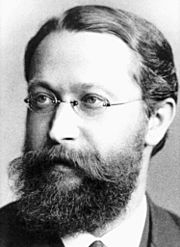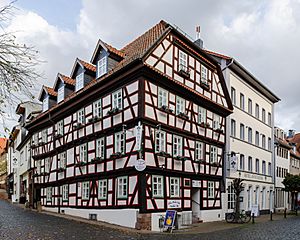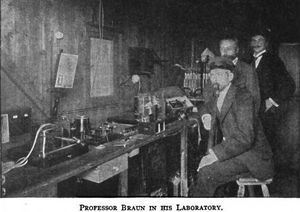Karl Ferdinand Braun facts for kids
Quick facts for kids
Karl Ferdinand Braun
|
|
|---|---|
 |
|
| Born | 6 June 1850 Fulda, Electorate of Hessen, German Confederation
|
| Died | 20 April 1918 (aged 67) Brooklyn, New York City
|
| Nationality | German |
| Alma mater | University of Marburg, University of Berlin |
| Known for | Cathode ray tube Cat's whisker diode Sparkless antenna circuit Phased array Le Chatelier-Braun principle computer monitor |
| Awards | Nobel Prize in Physics (1909) |
| Scientific career | |
| Fields | Physics |
| Institutions | University of Karlsruhe, University of Marburg, University of Strassburg, University of Tübingen, University of Würzburg |
| Doctoral advisor | A. Kundt, G. H. Quincke |
| Doctoral students | L. I. Mandelshtam, A. Schweizer |

Karl Ferdinand Braun (born June 6, 1850 – died April 20, 1918) was a German scientist. He was an electrical engineer, inventor, and physicist. He won the Nobel Prize in Physics.
Braun made big contributions to how we use radio and television today. He shared the 1909 Nobel Prize in Physics with Guglielmo Marconi. They won for their work on "wireless telegraphy," which was an early form of radio communication.
Contents
Karl Ferdinand Braun: A Pioneer in Technology
Early Life and Discoveries
Karl Ferdinand Braun was born in Fulda, Germany. He studied at the University of Marburg. He earned his PhD from the University of Berlin in 1872.
In 1874, Braun made an important discovery. He found that a special type of semiconductor could change alternating current into direct current. This process is called "rectifying." This was a key step for future electronics. In 1895, he became a professor of physics at the University of Strassburg.
The Cathode-Ray Tube (CRT)
In 1897, Braun built the very first cathode-ray tube (CRT). He also created the first CRT oscilloscope. The CRT became super important for making fully electronic television.
For many years, CRTs were used in most TV sets and computer monitors. Later, newer technologies like liquid crystal display (LCD) and light emitting diode (LED) screens took over. But in some countries, like Germany, the CRT is still called the "Braun tube."
Improving Wireless Communication
Braun also worked a lot on wireless telegraphy, which is how early radio signals were sent. In 1897, he became one of the first people to work on wireless technology.
His main ideas helped make radio signals stronger and clearer. He added a "closed tuned circuit" to the radio transmitter. This helped keep the radio waves steady. He also separated the antenna from the main part of the transmitter. He did this using "inductive coupling." This made the signals travel much further.
Around 1898, he invented a crystal detector. This device helped receive radio signals better. Braun spent many years focusing on solving problems in wireless communication. He wrote many articles about his work. In 1899, he applied for a patent for "Wireless electro transmission of signals over surfaces."
Early radio pioneers had trouble sending signals over long distances. Braun's new circuits made the signals last longer. They also lost less energy. This meant stronger signals that could travel much further.
In 1905, Braun invented the phased array antenna. He explained how he carefully set up three antennas to send a signal in a specific direction. This invention was very important. It led to the development of radar, smart antennas, and other modern communication systems.
The Nobel Prize and Later Life
Braun's ideas on tuning radio circuits were used by Guglielmo Marconi. Marconi later admitted that he had "borrowed" some of Braun's work. In 1909, Braun and Marconi shared the Nobel Prize in Physics. They won for their "contributions to the development of wireless telegraphy."
Braun started his experiments at the University of Strasbourg. Soon, he was able to send signals 42 kilometers away to the city of Mutzig. In 1899, Braun and his team went to Cuxhaven. They continued their experiments by the North Sea.
On September 24, 1900, they regularly exchanged radio signals with the island of Heligoland. This was a distance of 62 kilometers. Later, light vessels on the Elbe river and a station at Cuxhaven started a regular radio telegraph service.
At the start of World War I, Braun traveled to the United States. He went there to be a witness in a patent lawsuit. It was a case between the Marconi Corporation and a wireless station in Sayville, New York. When the U.S. entered the war, Braun was detained. However, he was allowed to move freely within Brooklyn, New York. He died in his home in Brooklyn in 1918, before the war ended.
Awards and Inventions
Karl Ferdinand Braun Prize
In 1987, the Society for Information Display created the Karl Ferdinand Braun Prize. This award is given for amazing technical achievements in display technology.
Key Patents
- U.S. Patent 0,750,429, Wireless Electric Transmission of Signals Over Surfaces
- U.S. Patent 0,763,345, Means for Tuning and Adjusting Electric Circuits
See also
 In Spanish: Carl Ferdinand Braun para niños
In Spanish: Carl Ferdinand Braun para niños


